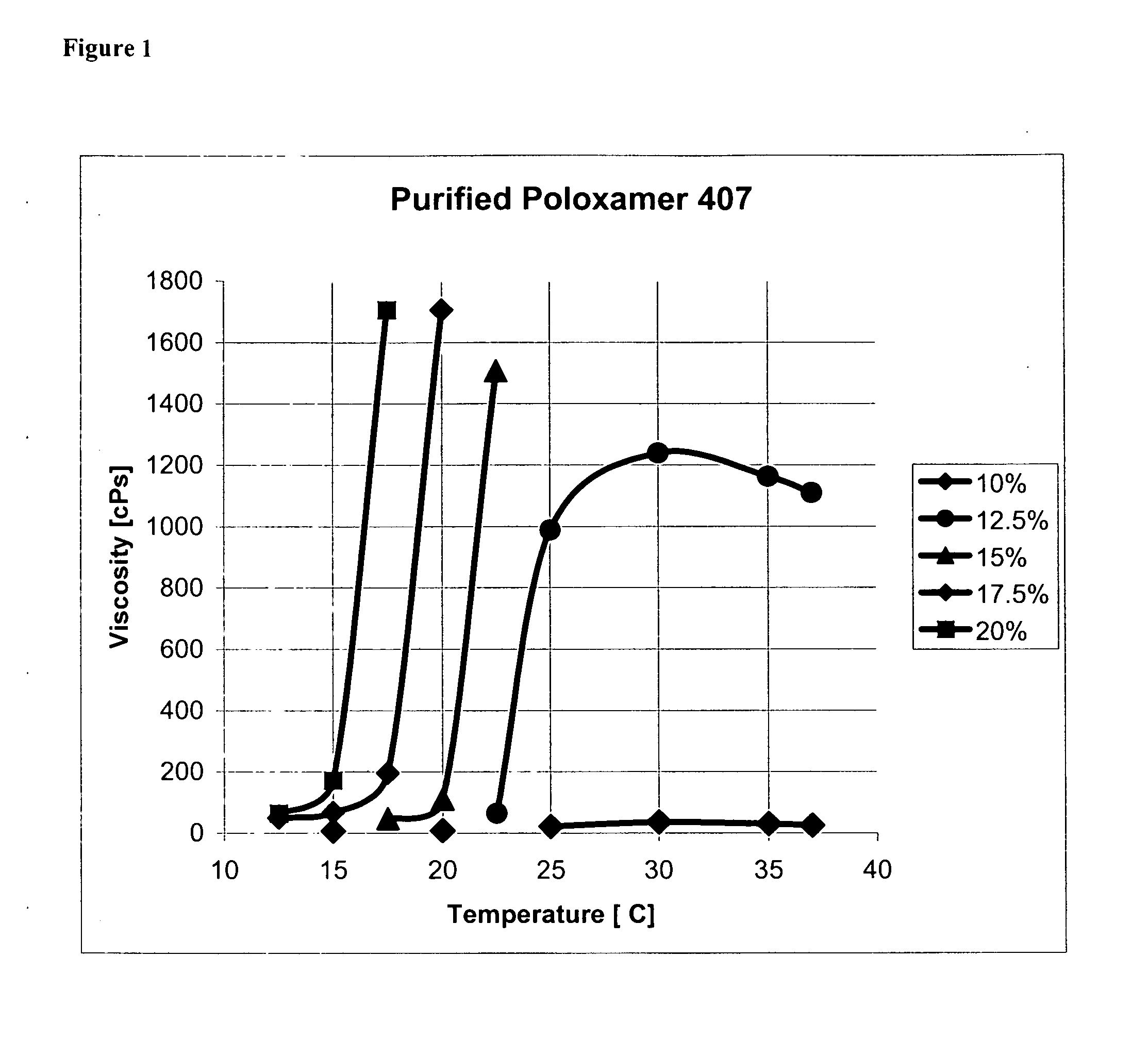Methods and kits for treating lacerations and puncture wounds using inverse thermosensitive polymers
a technology of thermosensitive polymer and lacerations, applied in the direction of dilators, bandages, drug compositions, etc., can solve the problems of insufficient improvement of the technique for controlling bleeding, laborious and frequent provision of acute and critical care, and limited modalities in many ways, so as to prevent exsanguination and/or septicemia, prevent rupture, or strengthen the d
- Summary
- Abstract
- Description
- Claims
- Application Information
AI Technical Summary
Benefits of technology
Problems solved by technology
Method used
Image
Examples
example 1
Purification of Poloxamer 407
[0140] Poloxamer 407 (486.0 g, lot number WPHT-543B), purchased from BASF Corporation, Mount Olive, N.J., was dissolved in deionized water (15,733 g). The solution was maintained at 0.1° C. and 2335.1 g of (NH4)2SO4 were added. The solution was equilibrated at 2° C. and after two distinct phases formed, the lower phase was discarded, and the upper phase (2060 g) was collected and weighed. Deionized water (14159 g) was added and the solution was equilibrated to 2° C. Next, 2171.6 g of (NH4)2SO4 were added with stirring. After the salt was dissolved, the solution was maintained at approximately 2° C. until two phases formed. The upper phase (3340 g) was isolated and diluted with 12879 g of deionized water. The solution was chilled to about 2.2° C. and 2062 g of (NH4)2SO4 were added. The phases were allowed to separate as above. The upper phase was isolated and extracted with 4 liters of dichloromethane. Two phases were allowed to form overnight. The organ...
example 2
In-Vitro Testing and Principal of Operation
[0141] The viscosity changes were measured in a Brookfield Cone and Cup viscometer with temperature control. A graph of the viscosity changes (FIG. 1) clearly shows polymer concentrations from approximately 12.5 w % until at least 20 w % will show steep increases in solution viscosities with temperature. The onset of gelation is dependent on the temperature and higher polymer concentrations lead to earlier onsets of gelation. Furthermore, polymer concentrations below approximately 12.5 w % do not demonstrate an increase in solution viscosity with temperature and remain liquid even at body temperature.
[0142] These two findings demonstrate the potential operation principle of the purified poloxamer 407. The polymer solution is injected as a soft gel at the temperature of a typical OR (about 18° C.) into the arteriotomy and the rise in temperature leads to a stiff gel. The gel will start to dissolve in blood and when the concentration of the...
example 3
Injectability of Purified Poloxamer 407 Through Various Needle Gauges
[0143] A three milliliter polycarbonate syringe (Merrit Medallion) was loaded in the cold with three milliliter of 20 w % purified poloxamer 407. Various sized needles were attached via a luer lock and the injectability of the polymer solution was tested at 6° C. (liquid state) and at room temperature (23° C.; soft gel state) as shown in the table below.
TABLE 2Injectability of 20 w % purified poloxamer407 through a 3 mL syringe.Needle6° C.23° C.16Geasyeasy18Geasyeasy21Geasyeasy25Geasypushable27Geasyrequiredhard push
[0144] The same experiment was repeated using a one milliliter polycarbonate syringe (Merrit Medallion) and in all cases, the polymer could be easily injected through the various needle gauges.
TABLE 3Injectability of 20 w % purified poloxamer407 through a 1 mL syringe.Needle6° C.23° C.16Geasyeasy18Geasyeasy21Geasyeasy25Geasyeasy27Geasyeasy
PUM
| Property | Measurement | Unit |
|---|---|---|
| transition temperature | aaaaa | aaaaa |
| transition temperature | aaaaa | aaaaa |
| transition temperature | aaaaa | aaaaa |
Abstract
Description
Claims
Application Information
 Login to View More
Login to View More - R&D
- Intellectual Property
- Life Sciences
- Materials
- Tech Scout
- Unparalleled Data Quality
- Higher Quality Content
- 60% Fewer Hallucinations
Browse by: Latest US Patents, China's latest patents, Technical Efficacy Thesaurus, Application Domain, Technology Topic, Popular Technical Reports.
© 2025 PatSnap. All rights reserved.Legal|Privacy policy|Modern Slavery Act Transparency Statement|Sitemap|About US| Contact US: help@patsnap.com


